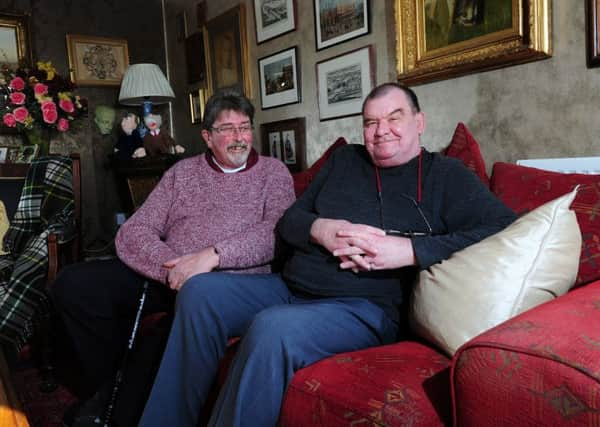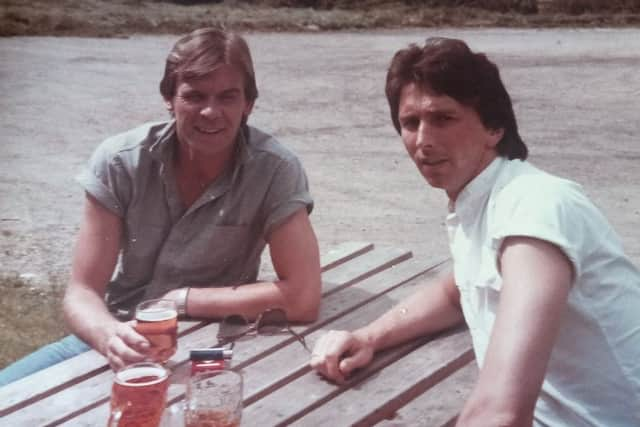A queer story of life and love: Leeds couple's hopes and fears for the '˜grey and gay' generation


John Roebuck remembers very clearly the day his mum threw him out of his home aged just 16.
He had just been involuntarily outed as gay, and his strict Catholic mum – who had her own demons to battle – just couldn’t accept it.
Advertisement
Hide AdAdvertisement
Hide Ad“All my clothes were thrown out of the bedroom window with two plastic bags to pack them in,” he recalls.


“But I knew when I was 10 or 11 that I was different. I didn’t know I was gay because you didn’t know what it was back then.
“It was never talked about. I just thought ‘I’m the only one in the world, what the hell’s wrong with me?’”
Fast forward almost half a century, and John, 62 and his civil partner Roy Blanchard, also 62, are approaching retirement age.
Advertisement
Hide AdAdvertisement
Hide AdAnd the isolation that John felt when he left his family behind him is looming again, although this time for very different reasons.


John and Roy are part of the ‘grey and gay’ generation who lived through periods of huge prejudice and protest, and eventually founded the modern LGBT rights movement.
The couple are volunteers with Sage, a Lottery-funded initiative which has been set up to support older members of the Leeds LGBT community.
The project is an offshoot of Leeds City Council’s Time to Shine initiative and the work of LGBT lobbying organisation Yorkshire MESMAC, which wants to reduce isolation and alienation of older people.
Advertisement
Hide AdAdvertisement
Hide AdIt wants to reach out specifically to older gay people who might now be in a care home, but don’t necessarily have the traditional family and friends support networks - and perhaps never did have.
Sage is also campaigning for the opening of the first dedicated OAP care home for the LGBT community in Leeds.
Roy and John are also part of the new Queer Stories project overseen by Leeds Museums and Galleries, which is chronicling the experiences of older gay people in Leeds to celebrate and preserve a key part of the city’s cultural landscape.
The couple have lived a happy and contented life on the whole, although it is littered with incidents of bigotry and threats of violence which they accept as part of their generation’s fraught journey towards equality.
Advertisement
Hide AdAdvertisement
Hide AdBut they have also seen the birth of the LGBT rights movement and the legalization of gay marriage – something neither of them thought they would see in their lifetimes.
The pair, who have been together for almost 40 years, hope to marry – “before one off us dies” they say jokingly.
In their apartment in Holbeck, they speak about their deep love for each other – joking that it’s more “pragmatic” than hearts and flowers nowadays – but also recall some of their nasty brushes with prejudice.
“I was once with a group of friends in a pub in Skipton,” says Roy, who is originally from Pudsey.
“We ordered drinks and sat at a corner table.
Advertisement
Hide AdAdvertisement
Hide Ad“We were not overly-raucous, but we were laughing and joking. Suddenly the manager came over and said ‘I have had complaints from other customers about you, get on your way’.
“We knew what it was – he just didn’t want half a dozen queers in his pub. When you have been prejudiced against like that, it leaves a bitter taste in your mouth.”
He also remembers “legging it” after being chased and taunted by a gang of skinheads in City Square, Leeds, in the early 1970s.
For John, the main source of hostility was his own mother, with whom he reconciled in later years before her death.
Advertisement
Hide AdAdvertisement
Hide AdWhen John and Roy got together, the gay rights movement as we know it was still in its infancy.
“There were more people coming out of the closet and they were becoming more visible,” Roy says.
“But we would often go to places where gay people weren’t welcome at all.”
Events they supported would be banned and even the mere handing out of publicity leaflets would attract open hostility from both the public and some sections of the press.
Advertisement
Hide AdAdvertisement
Hide AdIt was a Yorkshire Evening Post agony aunt who helped Roy come to term with his own sexuality, which he too had been aware of from a very early age.
“She helped me come out in 1971,” he recalls.
“She was replying to somebody who was feeling totally isolated, and the words sort of flew off the page and hit me. I always meant to write and thank her, but never did.”
He says the advent of civil partnerships 30 years later in 2004 was something he “could not believe”.
“I never thought I would see it in my lifetime,” he says.
“We are thinking about converting ours (performed in 2006) to marriage now. No ceremony, we are past all that. But just to have a marriage certificate.”
Advertisement
Hide AdAdvertisement
Hide AdJohn adds: “I can’t say that it was our aim to be able to get married. Back then we would have been happy just to be accepted without any prejudice. What we wanted was equality.”
“What we wanted more than anything was to be accepted as a couple,” says Roy.
“We were both mindful that we would never have pots of money.
“But if one of us dies, the family that we have barely spoken to could walk in here and take half of what there is. So we always wanted some kind of protection under the law.”
Advertisement
Hide AdAdvertisement
Hide AdThe inevitable effects and consequences of ageing are particularly poignant for Roy and John. John has cancer and Roy has also suffered from a variety of illnesses. He was given just 12 months to live back in 2012 but has battled his way to a slightly better health outlook.
“We are nearing retirement age and it’s all coming home to roost now with that older LGBT generation,” says Roy.
“We have been quite lucky really.
“When you hear some of the stories that come out from the older folk, we did alright.
“We hear stories of people being dragged off to the doctors to have the ‘gayness’ taken out of them and ‘cured’.
“Exclusion from the family is a big one.
Advertisement
Hide AdAdvertisement
Hide Ad“When you lose your family, and there’s no other support, where do you go?
“If anything happened to either of you, what would you do?”
He recalls an incident when he collapsed in the bathroom.
“I just remember thinking ‘thank God John’s here’.
“He is the love of my life. I couldn’t imagine life without him.”
John agrees that they have had a “wonderful life” but he too is wary that “there are other people out there who are older and much worse off than us”.
That’s why the couple are campaigning alongside the Sage project and Yorkshire MESMAC for better services for older LGBT people.
Advertisement
Hide AdAdvertisement
Hide AdWhile mainstream services include luncheon club networks and a host of other facilities to tackle isolation, campaigners say there are fears that scores of LGBT elders may be slipping through the care net.
“This is one of the things that Sage is trying to do,” says Roy. “Get to people who are in homes, and get to those who are caring for them, to help them to be more sensitive that some of the people they are looking after might have a story and needs that are different to everyone else’s.”
The campaign is actively approaching various care bodies in both the public and private sector and talking to management staff.
The ultimate plan is to open a dedicated care home for older LGBT people, or an “LGBT commune”, as Roy prefers to call it.
Advertisement
Hide AdAdvertisement
Hide Ad“It’s just about making people aware that there could be somebody who is terrified. And to look for somebody who is not going into dementia, but they are always apart, and see if maybe they would like a discreet visitor,” explains Roy.
“A lot of people I come across are amazed that I still want to think ‘gay’ in my sixties.
“They seem to think ‘oh you left all that behind’.
“It just makes me wonder if the misconception in a lot of straight minds is that the sole definition of being gay or lesbian is sexual!
“For a gay older person with no family, no loved ones, to suddenly find themselves isolated and alone in a care home surrounded by all these grannies and grandads having family visits, can you imagine what it would be like?”
The Sage project
Advertisement
Hide AdAdvertisement
Hide AdSAGE is a project run by Time to Shine which is focused on reducing the isolation faced by older LGBT people. It offers activities and events, and is always looking for new volunteers. For more information, or to get involved, call Jude Woods on 0113 244 4209 or email [email protected].
Queer Stories is a social history project which aims to collect, celebrate and preserve a living archive of Leeds’s older LGBT community.
Sage is supported by the Lottery Fund. Queer Stories is backed by the Heritage Lottery Fund.